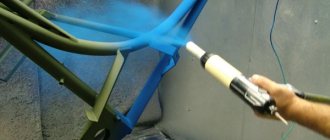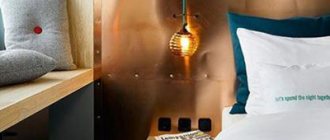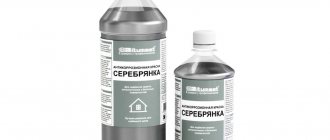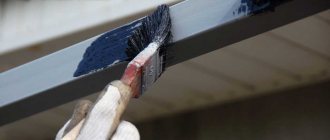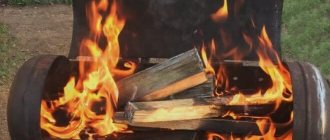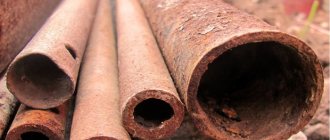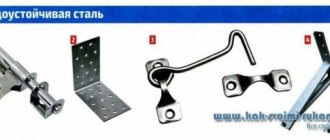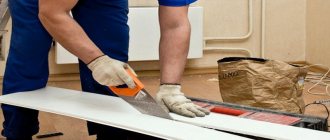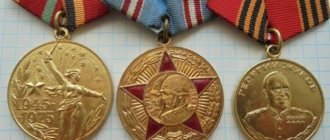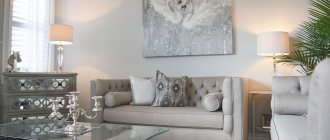Options for aging metal by decorative painting
When painting metal products, two goals are pursued: protection against the formation of corrosive areas and giving the metal an aesthetic appearance. When implementing the last task, sometimes it is necessary to cover the surface in 2-3 layers. But the end result may not always be just painting. Sometimes metal products need to be given original decorative effects, for example, the appearance of an aged object. For this purpose special technologies are used. Let's try to figure out how to paint antique metal and what is required for this.
Aging materials
You can achieve the effect of aged metal by using the main method - aging through the creation of a patina and the formation of abrasions. Patina is applied with special paints, but for metal, acrylic-based metallic compounds are more often used. In stores today there is a wide range of such paints; in addition to their decorative function, they also perform a protective function.
There is a choice of acrylic paints for aged metal, namely:
- brass;
- bronze;
- copper;
- gold.
Thanks to modern technologies, an aged effect can be given not only to metal surfaces. Often this painting is performed on plastic, wood and plaster products.
The aging process is completed by applying a final protective layer. For this they often use:
- acrylic-based varnish, which has a high degree of gloss;
- very durable polyurethane-based varnish with a gloss level of up to 50%;
- polyurethane-based varnish with a matte effect.
How to age metal yourself?
The choice of method for creating an interior style, which assumes the presence of traces of antiquity in the design, is quite wide. For connoisseurs of this style, it is not always affordable to purchase real old items. The way out of this situation is to imitate ancient metals. How to properly paint antique metal with your own hands? Coloring is carried out in stages:
- Preparing the surface for painting. We get rid of dirt, rust and traces of grease by grinding and solvent treatment.
- Metal priming. In this way we achieve the formation of roughness on the surface for better adhesion of the paint. We choose a primer special for metal.
- Application of selected metallic paint. Experts advise performing the process using a regular brush, this way aging is achieved in the best possible way.
- Aging stage. When the paint has dried, coat the surface with a special craquelure varnish. It is after this step that the metal object becomes covered with cracks, which create the effect of an old product.
Important! If non-metallic surfaces are being processed, then it is necessary to take a responsible approach to the choice of primer composition to achieve reliable adhesion with metallized paints.
On video: master class on applying patina to forged metal.
Bronze painting
In the old days, many objects were made of bronze. Therefore, painting products in bronze will help to decorate the interior of the house in an old style. There are several technologies for coating metal with bronze. Let's consider the simplest options.
Giving a monochromatic effect
You can perform a single-color coating of metal with bronze as follows:
- First of all, we clean the old surface from dirt and rust. To do this, you need to clean it with sandpaper and then degrease it.
- To increase the adhesion of the dye to the surface, we perform a metal priming process. In addition to adhesion, the primer will help further protect the product from corrosion.
- At the final stage, we begin painting with bronze paint. It is necessary to apply 2-3 layers evenly. But each subsequent layer is applied only after the previous one has completely dried.
Achieving the effect of antique bronze
Decorative antique painting with a bronze effect is suitable for lovers of rare things. To do this, follow these steps:
- Preliminary preparation of the old surface is carried out according to the same rules as in the previous case. Also, do not forget to coat the product with a primer.
- After priming, one layer of bronze paint is applied to the surface. It is desirable that the composition be applied evenly, but for an antique effect it is better to use a brush.
- After drying, the bronze painted surface becomes covered with patina (paint of a darker color). It is applied to the recesses. Experts advise using a translucent patina. This allows you to adjust the shade of the bronze coating.
- The next stage is glazing, that is, processing with a brush that is barely moistened with light paint. The process is carried out on all protruding edges and corners. This aging method allows you to give the product the effect of wear and tear, which usually appears on metal over the years.
- Next, we wait a while, allowing the applied materials to dry completely, and finally we coat the product with transparent varnish.
Surface preparation
- Remove all dust, dirt, grease, oil, salt and chemical stains by washing the surface with soap and water or other suitable cleaning methods. Rinse with clean water and dry the surface thoroughly.
- Remove loose paint and rust with a stiff brush or 80-150 sandpaper. Previously coated surfaces should be intact and in good condition.
- Smooth, hard or glossy coatings should be lightly sanded (matted) with sandpaper or an abrasive sponge with a grit size of 180-220 to improve the adhesion of the subsequent coating. Remove all sanding dust with a vacuum cleaner, then wipe with a damp, lint-free cloth and dry the surface thoroughly.
- Apply primer to dark surfaces to enhance the color of the finish. The primed surface can be painted after 4 hours.
Decorative metal painting | StroySovet
Bronze metal painting
Imitation of precious metals is very common, since not everyone can afford to actually use them. Paints “bronze”, “silver” and “gold” were invented a long time ago, but until recently they were prepared on the basis of organic solvents. These greatly narrowed the scope of their possible use due to a persistent unpleasant odor and intolerance to temperature changes.
Today, in any hardware store you can find water-based and acrylate-based metallic paint. It is safe, easy to use, resistant to high temperatures and even protects the metal base of the structure from corrosion.
There are two options for painting “bronze”. Let's look at them step by step.
Method No. 1 Plain coloring:
- We clean the surface of the metal structure from dirt and traces of corrosion, and degrease it.
- We apply a metal primer to increase adhesion and create an additional polymer layer to protect against rust.
- After the primer has completely dried, apply metallic paint with a bronze tint in an even layer in 2-3 layers, each time waiting for it to dry completely.
- We prepare the metal similarly to the previous method, we also apply a primer and an even layer of bronze paint.
- All recesses are treated with a darker compound (patina), often translucent, so that the degree of darkening can be adjusted.
- After the previous layer has completely dried, glazing is carried out with an almost dry brush - you need to paint light paint on all corners and protruding elements of the metal structure as if it had simply been worn away by time.
- After waiting for the next layer to dry, we fix the result with transparent varnish.
- We prepare the surface of the metal structure for painting: we clean it from dirt, corrosion, grease traces, and grind it.
- Apply a layer of metallic paint to a dry and clean surface.
Note! To imitate antique metal, it is best to apply paint with a brush - a slightly uneven coating will only work to our advantage. - After the paint has completely dried, apply an even layer of craquelure primer. It can also be found at most hardware stores. This composition, after drying, forms a transparent polymer film on the product.
- The last stage is the top craquelure coating. This is what gives the material the color of old, corroded metal. After the layer dries, small cracks – craquelures – form on the surface.
Method No. 2 Ancient bronze
By following these instructions, you can “ennoble” any metal, and even other materials can be “bronzed”.
Article Sponsor
:
LLC NPP Spectr
Moscow
Business can be successful only when you do your job not just skillfully, but better than others.
We are always open for cooperation.
Do-it-yourself antique metal painting
There are a lot of interior styles that it is advisable to decorate with objects with traces of time: from classic to steam-punk. Real objects that were in use several decades, or even centuries ago, are very expensive, require special care and restoration, and often create discomfort in everyday life. The most successful option in this case is imitation of ancient metal.
Let's look at how to achieve this step by step:
Imitation of ancient metal is possible both on metal products and on any other material. You just need to choose the right primer for good adhesion.
Upon completion of work
Clean the valve by turning the can upside down and holding it spraying for 3-5 seconds, then wipe with a dry cloth. (Be careful not to accidentally stain yourself or other objects.) If the valve becomes clogged, twist and remove the nozzle, rinse it with a solvent, such as white spirit.
Clean the surface from wet streaks and drops of paint with xylene or white spirit.
How to paint metal like old bronze
Light antique painting is a fairly popular operation when creating various interiors. It is traditionally believed that antique items add an element of sophistication and luxury, emphasizing the style and wealth of the owner of the room. However, genuine antiques are highly expensive and often require restoration and special care.
It is much easier to simulate the aging of an object. And today this art is mastered not only by artists, but also by painters and simply amateurs. So, it will be quite possible for you to paint antique furniture if you set yourself such a task. But before you tackle your great-grandmother's chest of drawers, practice on something less valuable.
Methods for aging wood and other materials
There are several ways to age furniture and other types of materials:
Painting wooden elements
The most ordinary things can be turned into decorative furniture or accessories that are not inferior to antique items in terms of sophistication and the ability to create a special atmosphere in the room.
The question of how to paint antique wood arises when you want to make original and sophisticated-looking details using existing interior elements.
Antique painting of wood is quite possible at home; all you need is the most common tools. Before painting, it is necessary to carry out preliminary preparation of the object to be decorated.
Before aging a product, several stages of work are carried out:
- The surface of the object being processed is cleaned. Varnish, old paint, and any other coating are removed from wood. Those parts and fittings that are not planned to be painted are dismantled.
- The surface is polished and then cleaned from dirt and dust.
- The surface is primed with antiseptic compounds to avoid subsequent rotting or mold damage. The primer will also ensure the paint adheres better.
It is not recommended to use putty when preparing to age wood. With this design solution, the emphasis is on the presence of small defects in the wood, so you should not completely mask the flaws.
Creating the effect of dilapidation and wear
Artificially giving wood a shabby and dilapidated look is called brushing. The production uses sandblasting, during which soft fibers are removed from the top layer, causing the structure of the wood to become more pronounced.
Precautionary measures
- Do not insert a pin or other objects into the canal. Pressurized cylinder. Protect from direct sunlight and heat above 50°C. Do not pierce or burn even after use. Do not spray near open flames or hot objects. Do not smoke while working. Cylinders may only be thrown into designated areas.
- FIRE HAZARD! Flammable vapors. Keep away from heat, sparks and flame. VAPOR MAY CAUSE SPONTANEOUS COMBUSTION. Extinguish all fire sources and burners, turn off stoves, heaters, electric motors and other sources of ignition while spraying. Prevent fumes from accumulating by opening all windows and doors to create drafts.
- May cause dizziness, headaches, nausea, and irritation to the eyes, skin, nose, and throat. Wear eye protection, chemical resistant gloves, protective clothing and a respirator.
- Avoid contact with eyes. If contact occurs, rinse eyes with plenty of water for at least 15 minutes. Do not take orally. If swallowed, consult a physician. Avoid getting vapors into the respiratory tract. Ensure good ventilation during application and drying. If you experience difficulty breathing, watery eyes, or headaches, increase the flow of fresh air. Wash your hands thoroughly after work.
- Keep away from children!
Types of dye and their advantages
Previously, bronze paint contained organic solvents. This resulted in a strong odor coming from the paint. Nowadays, instead of outdated compositions, mixtures are used for coloring metals. They are water soluble and contain only natural ingredients.
Modern dyes now contain metallic pigments of natural origin. They use acrylic dyes as binding elements.
Painting metals bronze has the following advantages:
- Environmentally friendly and odorless.
- Low price, which is explained by the water-based paint composition for metal.
- Possibility of obtaining various natural stylizations (for example, antique).
- Ease of processing products.
- Reliable protection of metal surfaces from moisture and corrosion.
- The service life of surfaces painted with this composition is tens of years.
If the surface is pre-painted with a layer of electrically conductive paint, its corrosion protection is simplified due to the formation of a galvanized film.
Also, the advantages of bronze dye include high resistance of the coating to UV radiation and external mechanical influences.
What you need to know about paint
When deciding to independently design a metal door to look like antique bronze, you need to confidently navigate the method of preparing metal for the procedure, paints, and methods of proper application.
First of all, it is necessary to remember that metal products are dependent on the influence of external factors, the main one of which is moist air, which contributes to the formation of corrosive destruction. Metal paint is primarily intended to prevent such exposure. Secondly, modern paint compositions give the metal surface any color, durable protection, and if antique paint is used with the technique of “aging” the metal, it gives the appearance of almost any material suitable for the interior of a particular room or building.
To paint metal surfaces, paint and varnish mixtures are used, including organic solvents (such as white spirit and the like), as well as synthetic resins. During the drying process, they form protective paint films with characteristics of high density and strength. Such paints are used for processing metal elements in interior spaces, located on the outside of buildings and on streets. In this case, it is necessary to take into account the mode of use of the painted device or element. If this is an antique heating radiator, then the paint should be heat-resistant with high thermal conductivity.
For a long time, blacksmiths tried not to use coloring on their products to preserve the individual characteristics of handmade work. But modern paints, produced by manufacturers specifically for processing such products, make it possible to give the product additional elegance and originality, imitate almost any metal, cause a visual effect of aging, while providing reliable, long-term protection against corrosion. But it should be noted that the cost of such a coating is significant, but the price of forging is comparable.
Antique blacksmith products
Powder production
The production of powder takes place using industrial methods by repeatedly crushing bronze powder. After several stages of grinding, its separation is carried out in ball mills or pneumatic units.
Paints and varnishes based on bronze powder have significant hiding power. The quality of painting depends on the size of the fraction. The highest quality is powder, which, when sifted, forms a residue of no more than 1% (on sieve No. 0.045). To obtain a powder with maximum coverage, it is necessary to use bronze alloys rather than pure copper. With one gram of such powder you can cover up to 4500 cm² of surface.
